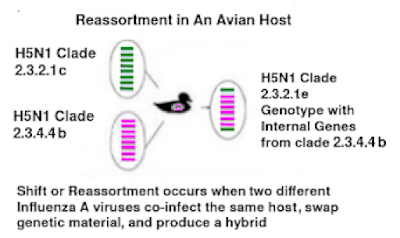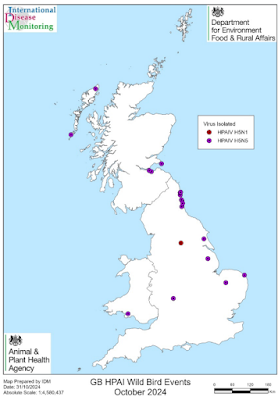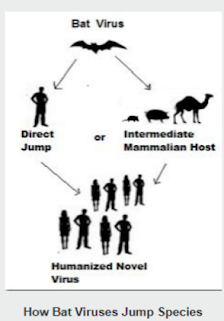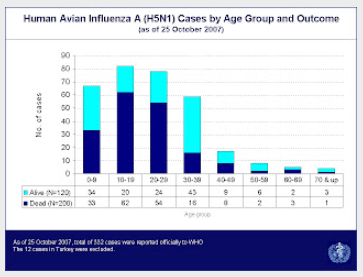#18,799
Late yesterday Raj Rajnarayanan @RajlabN - Associate Dean of Research and Associate Professor, NYITCOM at Arkansas State University - uploaded to X/Twitter a quick analysis of H5N1 sequences sampled from a HouseFly uploaded to @GISAID from California (2.3.4.4b B3.13 Collected Oct 2024).While this caused a bit of a stir online, it is not an unexpected finding.
Very early on in this blog (2007) - in Cats and Dogs and Flies, Oh My! - we looked at a 2006 study (see Detection and isolation of highly pathogenic H5N1 avian influenza A viruses from blow flies collected in the vicinity of an infected poultry farm in Kyoto, Japan, 2004 by Kyoko Sawabe et al.) that found that at least 2 types of flies could carry the H5N1 virus.
While flies weren't shown to be infected with the virus, they could ingest (and subsequently regurgitate or defecate) infected material, or potentially spread it mechanically by their feet or body, thereby spreading the disease.
Four years later Dr. Sawabe and his team would publish (Blow Flies Were One of the Possible Candidates for Transmission of Highly Pathogenic H5N1 Avian Influenza Virus during the 2004 Outbreaks in Japan) where they conclude:
We have suggested here that blow flies are likely candidates for mechanical transmission of HPAI because of their ecological and physiological characteristics as reviewed here. In fact, blow flies have already been recognized as important vectors for mechanical transmission of several serious infectious diseases, that is, poxvirus [28], rabbit hemorrhagic disease [29], and paratuberculosis [30]. Recently, it has been reported that the H5N1 viral gene was detected in house flies [31] and engorged mosquitoes [32].
While we're not talking about classically 'infected' flies, it seems likely that contaminated flies may be one of many contributors to the spread of the HPAI virus.
Eighteen months ago, we looked at a preprint (later published in Sci Repts: Blowflies As Potential Vectors Of Avian Influenza) that tested blowflies for HPAI at the national wildlife reserve in Izumi City, Kagoshima Prefecture, which is the overwintering home for thousands of endangered Hooded Cranes.Much in the same way that contaminated personnel or vehicles moving between farms can spread the virus (see the APHIS/USDA epidemiological investigation into the spread of H5N1 in Michigan).
In December 2022, 648 Calliphora nigribarbis were collected. Influenza virus RT-PCR testing identified 14 virus-positive samples (2.2% prevalence), with the highest occurrence observed near the crane colony (14.9%). Subtyping revealed the presence of H5N1 and HxN1 in some samples. Subsequent collections in December 2023 identified one HPAI virus-positive specimen from 608 collected flies in total, underscoring the potential involvement of blowflies in HPAI transmission.
Our observations suggest C. nigribarbis may acquire the HPAI virus from deceased wild birds directly or from fecal materials from infected birds, highlighting the need to add blowflies as a target of HPAI vector control.
`Until now, countermeasures have been taken based on the assumption that small animals and people will bring the virus. There was no improvement, and when we suspected it was a fly, a virus was detected.
We will conduct a more detailed investigation, take measures to prevent fly intrusion, and verify their effectiveness."
HPAI H5 has become pervasive in wild birds, and has spilled over into numerous terrestrial and marine mammals, making its containment or control far more difficult than it was even a few short years ago.
Evidence suggests the HPAI virus spreads through multiple, highly complex, processes. Yet we continue to takes something less than a holistic approach, still hoping they will contain the threat.
The USDA's Enhanced Biosecurity guidance (updated 6/25) focuses primarily on `big ticket' items like limiting visitors, disinfecting tools and shoes, and avoiding the mixing of animals species.
While all are reasonable recommendations, they haven't prevented the spread of HPAI H5 to nearly 1,100 dairy herds, and more than 1,700 poultry farms in the United States since late 2021.
In addition to flies as potential vectors, we've looked at a number of other `less obvious' ways the virus may be spreading.
- There is growing evidence that HPAI may be spread via `contaminated dust particles' - carried by the wind - from one farm to the next (see Preprint: Genetic & Meteorological Data Supporting Windborne Transmission of HPAI H5N1).
- The role of peridomestic mammals - particularly in and around farms - in the spread of HPAI is only partially understood, and remains under-researched (see Emer. Microbe & Inf.: HPAI Virus H5N1 clade 2.3.4.4b in Wild Rats in Egypt during 2023).
- While contaminated milking machines have been blamed for the cow-to-cow spread of HPAI, a recent preprint (Dairy Cows Infected with Influenza A(H5N1) Reveals Low Infectious Dose and Transmission Barriers) was unable to duplicate transmission in a controlled lab setting, leading researchers to warn `. . . Other agent, host, and environmental cofactors that might contribute to transmission cannot be ruled out and must be explored . . . ).
But research remains sporadic, with many farmers - fearing loss of income or the stigma of infection - opting for a `Don't test, don't tell' strategy. The USDA's powers and jurisdiction - like the CDC's - are often limited in these cases.
How much house flies, windborne `poultry dust', or peridomestic rodents contribute to the spread of HPAI is unknown. But these are risk factors that could be better controlled than they currently are, and should be worth exploring.














